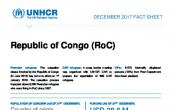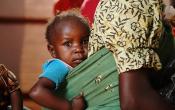Congo
Operation: Congo
Location
{"longitude":16,"latitude":0,"zoom_level":0,"iso_codes":"'COG'"}
By clicking on the icons on the map, additional information is displayed.
Key Figures
| 2017 year-end figures | |
| 280 | (out of 450) patients with moderate acute malnutrition (MAM) were discharged after treatment |
| 15.5 | litres, on average, of potable water available per person per day |
| 70% | of primary school-aged children were enrolled in primary education |
| 29% | of people of concern with disabilities received services for their specific needs |
| 25% | of households were living in adequate dwellings |
| 2018 planning figures | |
| 55% | of urban refugees will have access to primary health care services |
| 55% | of households’ needs for basic and domestic items will be met |
| 50% | of IDPs households live in adequate dwellings |
| 2,500 | Central African refugee children will be enrolled in primary education |
Latest Updates and Related Links
People of Concern
37%
Increase in
2016
2016
| 2016 | 71,598 |
| 2015 | 52,152 |
| 2014 | 59,105 |

[["Refugees",46457],["Asylum-seekers",6675],["IDPs",15303],["Returned refugees",11],["Others of concern",3152]]
Loading ...
Congo
< Back
2017
{"categories":[2013,2014,2015,2016,2017,2018],"budget":[32.08599964,37.62501547,35.34159306,32.00000031,28.642667152,23.47416797],"expenditure":[14.68758224,13.69277603,10.261615,9.33211215,12.21198154,null]}
{"categories":[2013,2014,2015,2016,2017,2018],"p1":[32.08599964,37.62501547,35.34159306,32.00000031,26.232864152,20.30416797],"p2":[null,null,null,null,null,null],"p3":[null,null,null,null,null,null],"p4":[null,null,null,null,2.409803,3.17]}
{"categories":[2013,2014,2015,2016,2017,2018],"p1":[14.68758224,13.69277603,10.261615,9.33211215,9.83463447,null],"p2":[null,null,null,null,null,null],"p3":[null,null,null,null,null,null],"p4":[null,null,null,null,2.37734707,null]}
Loading ...
CHOOSE A YEAR
- 2014
- 2015
- 2016
- 2017
- 2018
Operational context
The economy in the Republic of the Congo suffered from consequences of the oil price drop, unsustainable debt, and from weak governance. Following President Denis Sassou Nguesso re-election in March 2016, his government quickly called for unity, dialogue and national cohesion. Despite development efforts, the state of health and education systems continued to deteriorate, with a high negative impact on refugees and other vulnerable people.Police harassment and extortion remained as the main protection issues faced by refugees but improvements were made due to training and sensitisation of police officials.
More than 15,000 children, including refugees, were without birth certificates. However, the Republic of Congo hosted the International Conference on the Great Lakes Region (ICGLR) in October 2017 that adopted a ministerial declaration and plan of action on the eradication of statelessness. UNHCR is planning to further build on this opportunity with activities regarding the eradication of statelessness in 2018.
There was no improvement to the violence and insecurity in the Pool a department in the southern part of the country, and this triggered the launch of a Humanitarian Response Plan in July 2017, targeting some 138,000 IDPs and host communities.
Population trends
As of end 2017 there were close to 167,300 people of concern to UNHCR including some 107,800 IDPs, more than 48,500 refugees, close to 7,100 asylum-seekers and 3,900 others of concern. This was an increase of 133 per cent when compared to 2016, when the number of people of concern stood at some 71,600 people.Key achievements
- On 21 November 2017 UNHCR and the Government of the Republic of Congo signed Memorandum of Understanding, which aims at strengthening the Government’s capacities in emergency preparedness and humanitarian action.
- The operation raised funding from China for assisting 20,000 IDPs in accessing adequate and dignified housing and shelter, and other 50,000 IDPs to have adequate non-food items.
- 100 per cent of people of concern were registered on an individual basis.
- The cessation clause for Rwandans was prepared and is due to come effect on 1 January 2018. A total of 804 refugees were exempted, and the 8,400 who were not exempted will be considered as ‘others of concern’ to UNHCR as of January 2018.
- A total of 85 shelters were built in fired clay brick in refugee settlements of 15 Avril (Betou) and Ikpemgbele.
Unmet needs
- Only 33.3 per cent of households had their own latrines, far off from UNHCR’s standard of 85 per cent at the post-emergency stage.
- There was a need to renew deteriorated items of about 6,500 families.
- More than 300 shelters, about 20 community kitchens and almost all shelter roofs require major rehabilitation.
- UNHCR’s programmes in the Republic of the Congo continue to be poorly financed. In 2017 funding level stood at 25 per cent, and therefore refugees were becoming increasingly vulnerable.
Working environment
Given the unstable socio-political situation in the Central African Republic (CAR) and the Democratic Republic of the Congo (DRC), plans for voluntary repatriation of refugees may be undermined. Many refugees do not have access to proper documentation and are being denied protection and access to local facilities and services. UNHCR will continue to reinforce the Government’s capacity to facilitate access to land for refugees, examine requests for the recognition of refugee status determination (RSD) and facilitate integration and/or repatriation through the delivery of proper documentation.Key priorities
In 2017 UNHCR’s operation will focus on:• ensuring continuous registration of refugees;
• supporting the authorities in the RSD process;
• providing health care to Central African refugees ,especially to those with specific needs;
• responding to SGBV cases through community capacity building and projects related to income-generating activities through cash-based interventions.
In the event of a funding shortfall, assistance to people with specific needs, access to health care and local integration activities will be affected.



